Abstract
At histopathological diagnosis of non-Hodgkin's lymphoma (NHL) the mean number of mitoses in 10 high power fields (X 40) was determined in thin sections (2 micron) and designated 'mitotic index' (MI). In 38 patients the thymidine labelling index (LI) of the lymphoma cells was also determined. There was a close correlation between MIs and LIs (r = 0.81, P less than 0.001) indicating that MI reflects the proliferative activity in NHL. Among 101 patients with NHL classified according to the Kiel nomenclature MIs were generally lower in lymphomas of low grade malignant type than in the high grade malignant lymphomas. The variation of MIs within morphological subgroups was especially pronounced in high grade lymphomas. Only 18 of 49 patients (37%) with MI greater than or equal to 2 have survived for 2 years in contrast to 37 of 52 patients (77%) with MI less than 2 (P = 0.001). For patients with histologically low grade lymphomas and MI greater than or equal to 2.0 the median survival was 23 months and for those with MI less than 2.0 58 months (P = 0.09). Patients with high grade lymphomas and MI greater than or equal to 2.0 had a median survival of 15 months compared to 57 months for those with MI less than 2.0 (P = 0.04). In a multivariate analysis of 50 patients with centroblastic-centrocytic (CB-CC) or centroblastic (CB) lymphomas the importance of different prognostic factors was analysed. Among the variables age, MI, growth pattern (follicular vs. diffuse), cell type (CB-CC vs. CB), clinical stage (I vs. II-IV), initial chemotherapy (active vs. less active) only age and MI gave significant prognostic information. It is concluded that the assessment of mitoses in NHL gives prognostic information in addition to histopathologic classification. The method is simple and the proliferative activity and histopathological diagnosis can be ascertained routinely on the same occasion.
Full text
PDF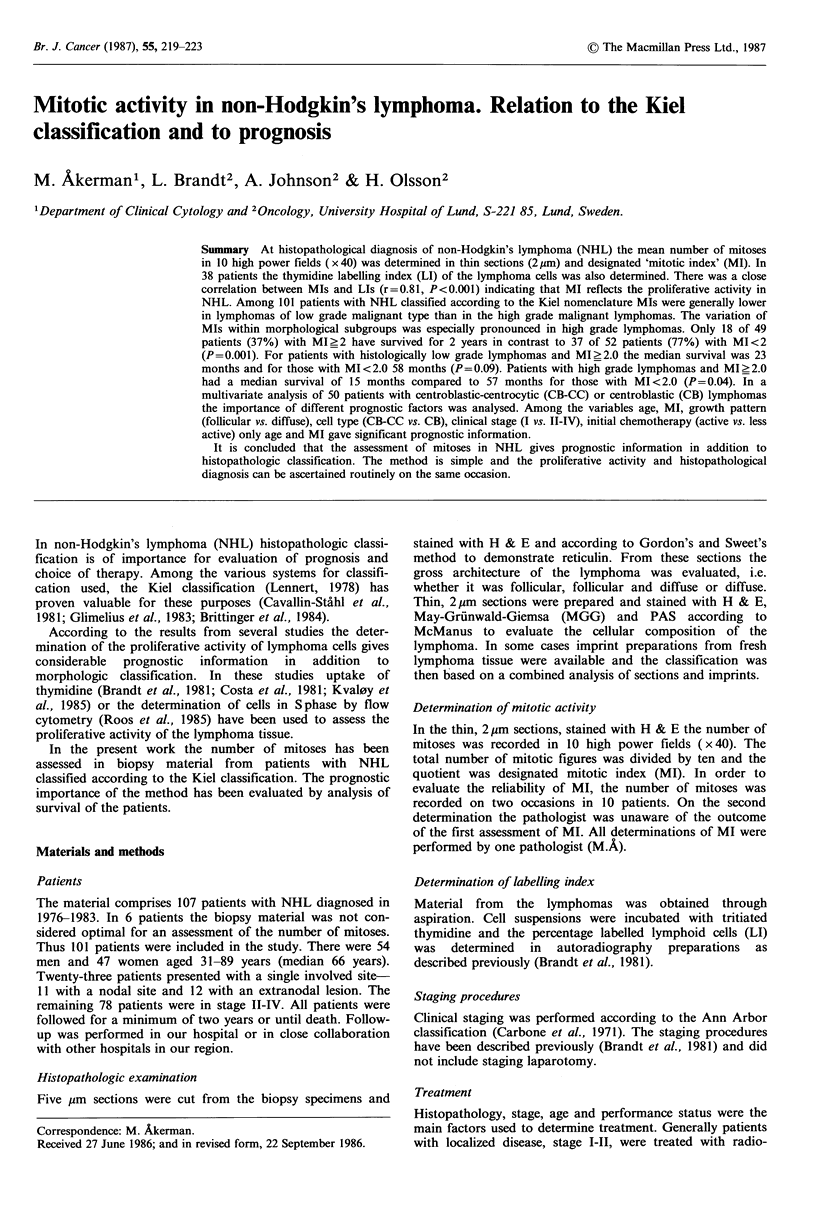
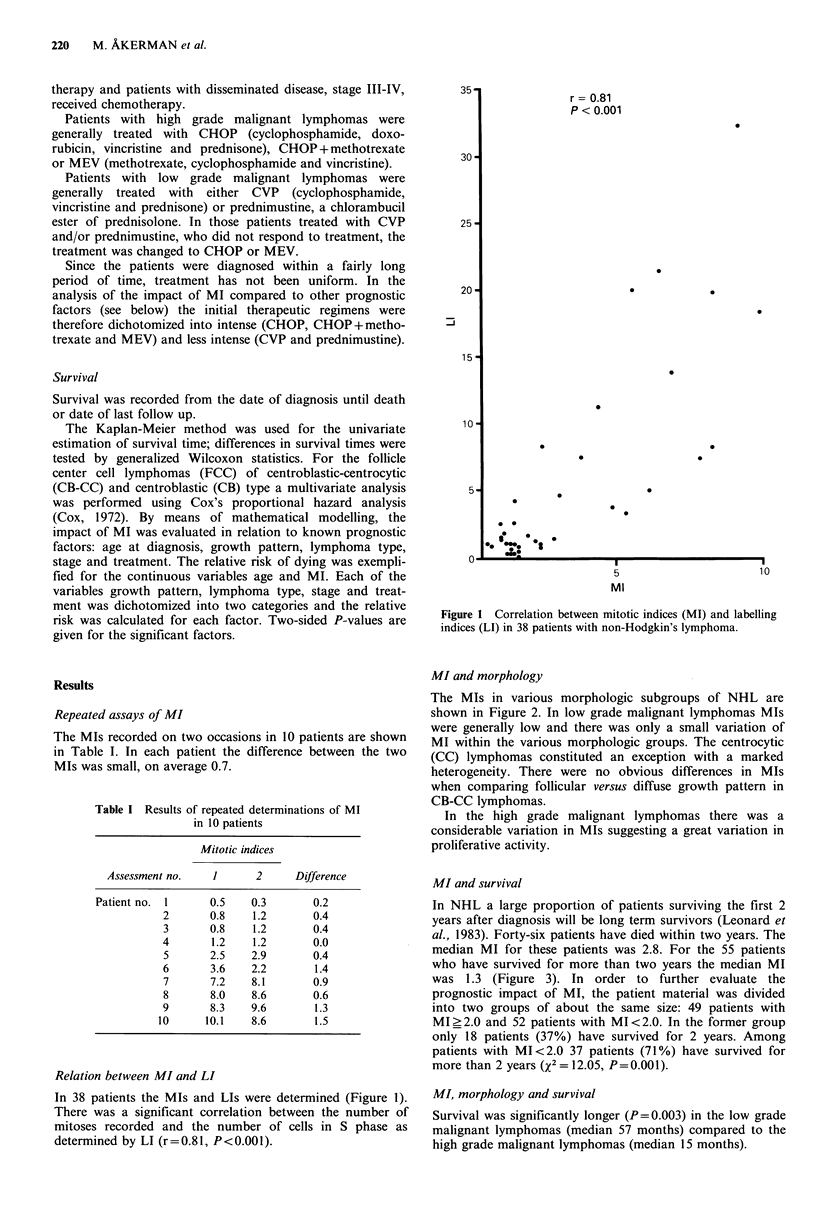
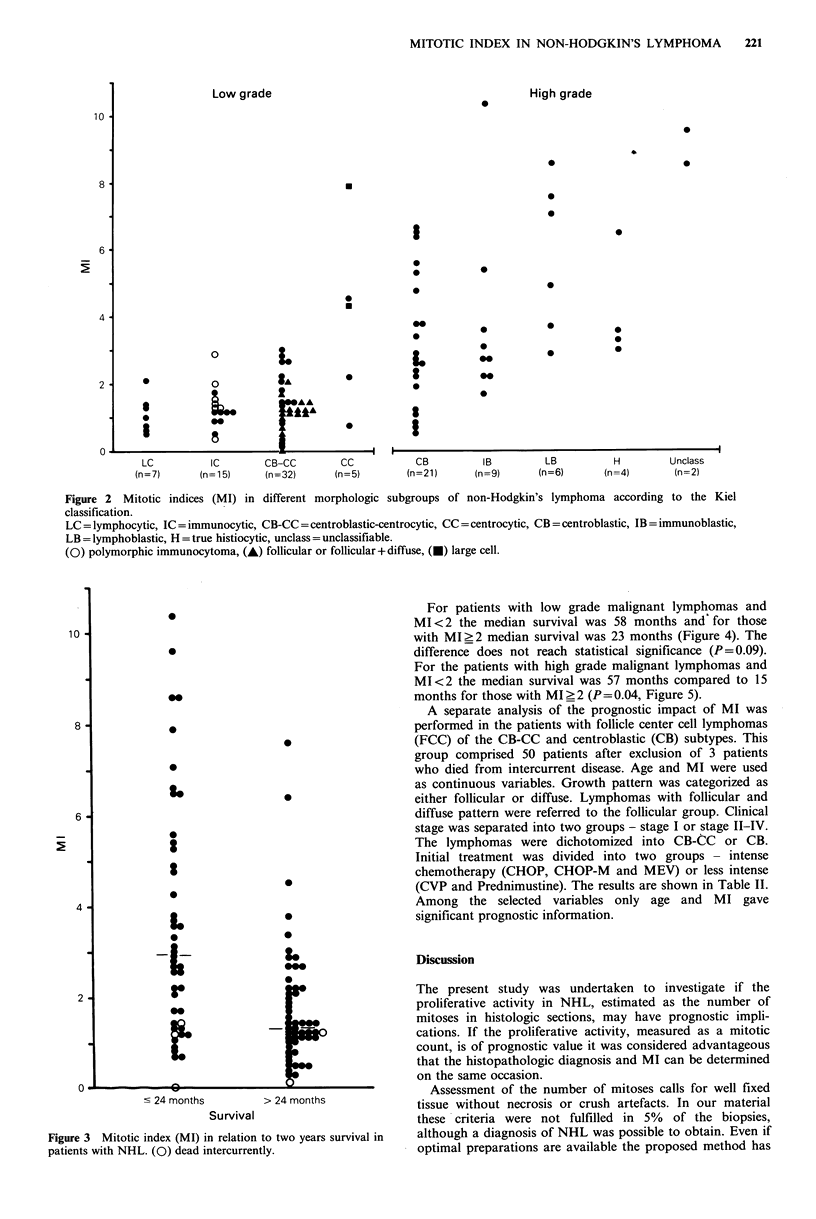
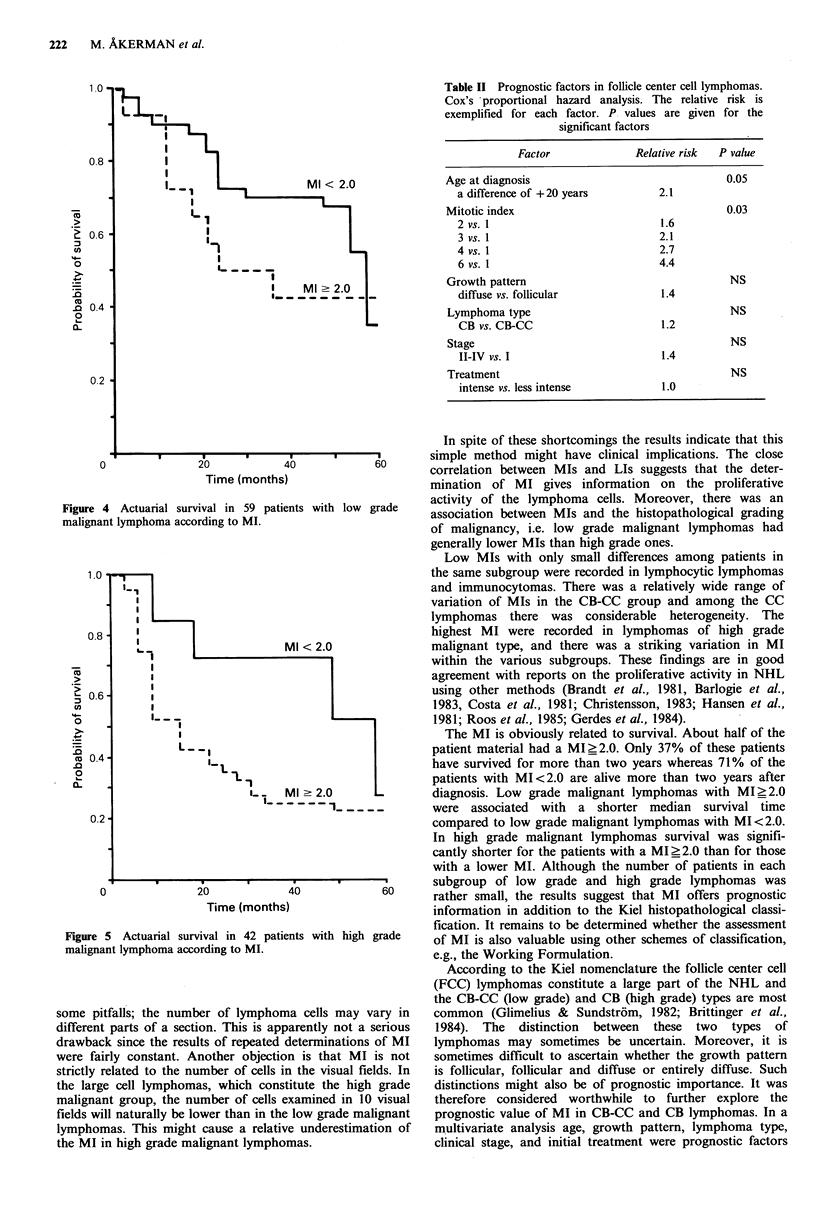
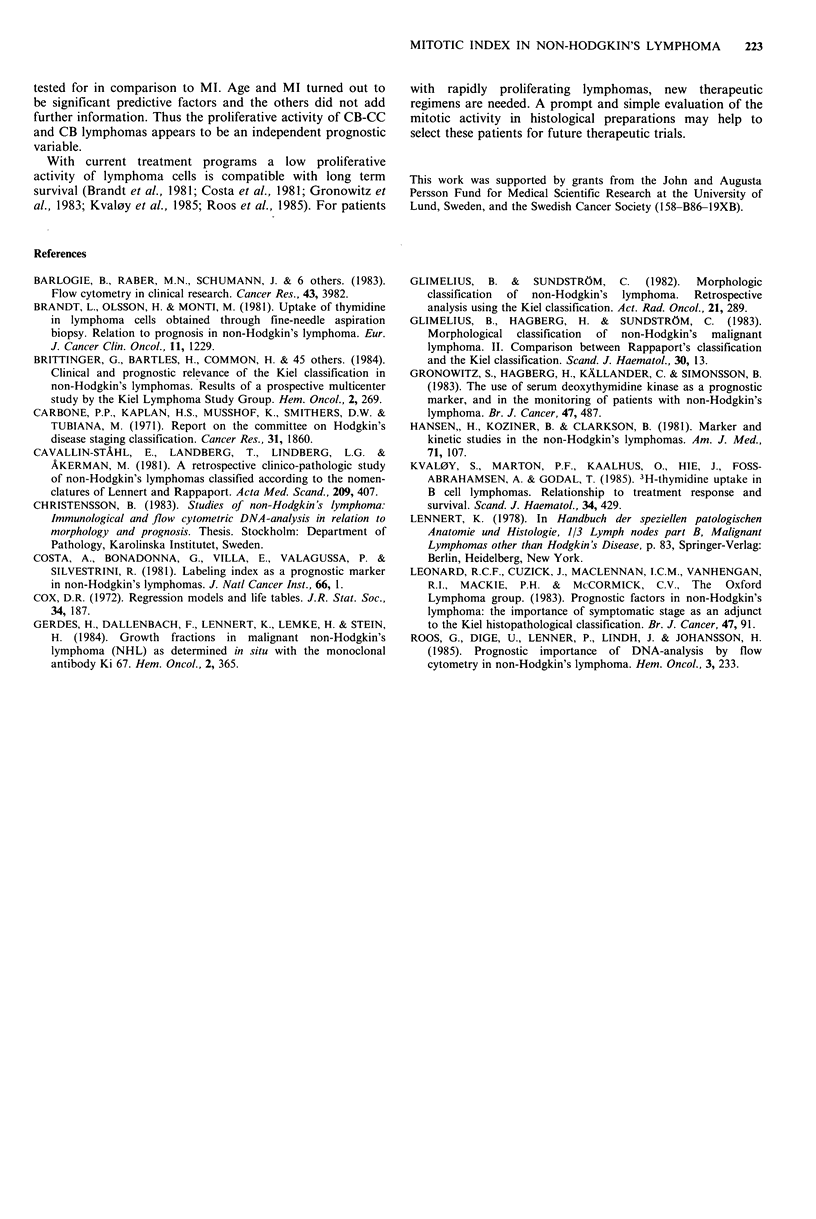
Selected References
These references are in PubMed. This may not be the complete list of references from this article.
- Barlogie B., Raber M. N., Schumann J., Johnson T. S., Drewinko B., Swartzendruber D. E., Göhde W., Andreeff M., Freireich E. J. Flow cytometry in clinical cancer research. Cancer Res. 1983 Sep;43(9):3982–3997. [PubMed] [Google Scholar]
- Brandt L., Olsson H., Monti M. Uptake of thymidine in lymphoma cells obtained through fine-needle aspiration biopsy. Relation to prognosis in non-Hodgkin's lymphomas. Eur J Cancer Clin Oncol. 1981 Nov;17(11):1229–1233. [PubMed] [Google Scholar]
- Brittinger G., Bartels H., Common H., Dühmke E., Fülle H. H., Gunzer U., Gyenes T., Heinz R., König E., Meusers P. Clinical and prognostic relevance of the Kiel classification of non-Hodgkin lymphomas results of a prospective multicenter study by the Kiel Lymphoma Study Group. Hematol Oncol. 1984 Jul-Sep;2(3):269–306. doi: 10.1002/hon.2900020306. [DOI] [PubMed] [Google Scholar]
- Carbone P. P., Kaplan H. S., Musshoff K., Smithers D. W., Tubiana M. Report of the Committee on Hodgkin's Disease Staging Classification. Cancer Res. 1971 Nov;31(11):1860–1861. [PubMed] [Google Scholar]
- Cavallin-Ståhl E., Landberg T., Lindberg L. G., Akerman M. A retrospective clinico-pathologic study of non-Hodgkin's lymphomas classified according to the nomenclatures of Lennert and of Rappaport. Acta Med Scand. 1981;209(5):407–414. doi: 10.1111/j.0954-6820.1981.tb11616.x. [DOI] [PubMed] [Google Scholar]
- Costa A., Bonadonna G., Villa E., Valagussa P., Silvestrini R. Labeling index as a prognostic marker in non-Hodgkin's lymphomas. J Natl Cancer Inst. 1981 Jan;66(1):1–5. [PubMed] [Google Scholar]
- Gerdes J., Dallenbach F., Lennert K., Lemke H., Stein H. Growth fractions in malignant non-Hodgkin's lymphomas (NHL) as determined in situ with the monoclonal antibody Ki-67. Hematol Oncol. 1984 Oct-Dec;2(4):365–371. doi: 10.1002/hon.2900020406. [DOI] [PubMed] [Google Scholar]
- Glimelius B., Hagberg H., Sundström C. Morphological classification of non-Hodgkin malignant lymphoma. II. Comparison between Rappaport's classification and the Kiel classification. Scand J Haematol. 1983 Jan;30(1):13–24. doi: 10.1111/j.1600-0609.1983.tb00629.x. [DOI] [PubMed] [Google Scholar]
- Glimelius B., Sundström C. Morphologic classification of non-Hodgkin's lymphoma. I. Retrospective analysis using the Kiel classification. Acta Radiol Oncol. 1982;21(5):289–297. doi: 10.3109/02841868209134018. [DOI] [PubMed] [Google Scholar]
- Gronowitz J. S., Hagberg H., Källander C. F., Simonsson B. The use of serum deoxythymidine kinase as a prognostic marker, and in the monitoring of patients with non-Hodgkin's lymphoma. Br J Cancer. 1983 Apr;47(4):487–495. doi: 10.1038/bjc.1983.78. [DOI] [PMC free article] [PubMed] [Google Scholar]
- Hansen H., Koziner B., Clarkson B. Marker and kinetic studies in the non-Hodgkin's lymphomas. Am J Med. 1981 Jul;71(1):107–123. doi: 10.1016/0002-9343(81)90265-5. [DOI] [PubMed] [Google Scholar]
- Kvaløy S., Marton P. F., Kaalhus O., Høie J., Foss-Abrahamsen A., Godal T. 3H-thymidine uptake in B cell lymphomas--relationship to treatment response and survival. Scand J Haematol. 1985 May;34(5):429–435. doi: 10.1111/j.1600-0609.1985.tb00773.x. [DOI] [PubMed] [Google Scholar]
- Roos G., Dige U., Lenner P., Lindh J., Johansson H. Prognostic significance of DNA-analysis by flow cytometry in non-Hodgkin's lymphoma. Hematol Oncol. 1985 Oct-Dec;3(4):233–242. doi: 10.1002/hon.2900030403. [DOI] [PubMed] [Google Scholar]


